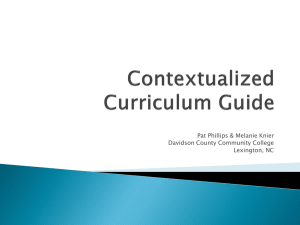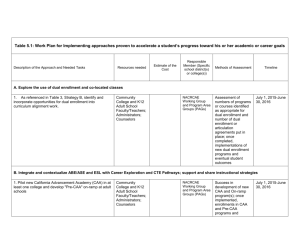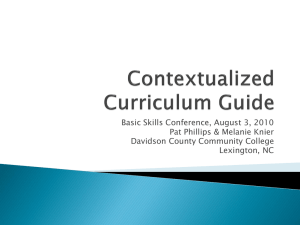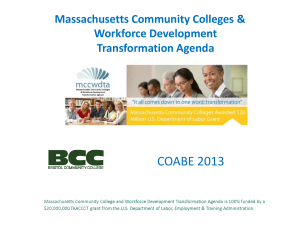Contextualized Teaching and Learning
advertisement
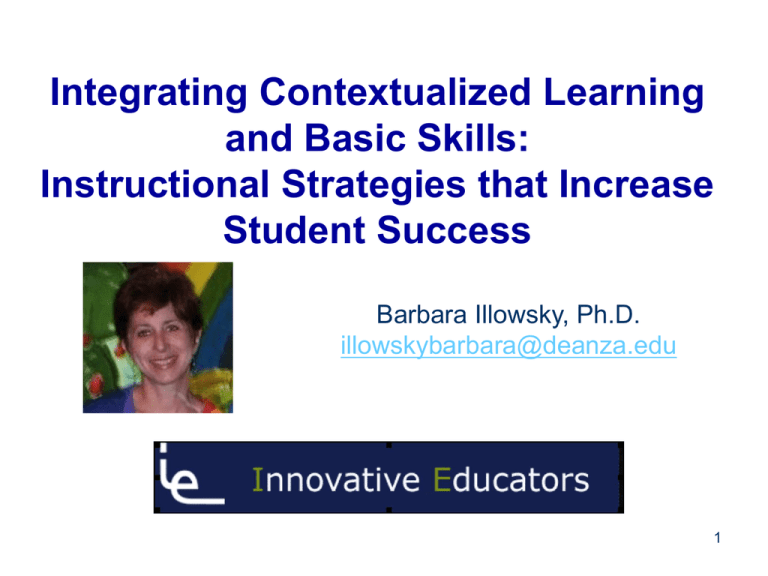
Integrating Contextualized Learning and Basic Skills: Instructional Strategies that Increase Student Success Barbara Illowsky, Ph.D. illowskybarbara@deanza.edu 1 Outcomes Attendees will be able to: • Identify topics in a particular existing course to insert contextualized content areas • Develop contextualized activities for those topics 2 Outcomes (cont.) • Understand how to collaborate with career technical education (CTE) and basic skills colleagues to develop contextualized teaching and learning (CTL) for CTE, and/or basic skills programs or learning communities • Learn strategies for engaging students with basic skills needs in the classroom 3 Why we need contextualized learning: education data • Of the 19.0 million new jobs between 2004 and 2014, 9.0 million are expected to involve higher level literacy (America’s Perfect Storm: Three Forces Changing our Nation’s Future, ETS) http://www.ets.org/perfect_storm/ 4 Why we need contextualized learning: the big picture http://www.youtube.com/watch?v=OhuV_rmf 5Mg (2009 version – if you have not seen this video before, you might be interested in watching it later) 5 Basic Skills Areas Traditionally: • • • • English writing Reading Mathematics English Second Language 6 What about here? 7 And here? 8 Why we are here We all need to work together! 9 What IS Contextualized Teaching & Learning? U.S. Department of Education Office of Vocational and Adult Education (2001): “a conception of teaching and learning that helps teachers relate subject matter content to real world applications” 10 What IS Contextualized Teaching & Learning? Mazzeo (2008): “diverse family of instructional strategies designed to more seamlessly link the learning of foundational skills and academic or occupational content by focusing teaching and learning squarely on concrete applications in a specific context that is of interest to the student” 11 What IS Contextualized Teaching & Learning? Wider Opportunities for Women (2011): “Functional Context Education (FCE) is an instructional strategy that integrates the teaching of literacy skills and job content to move learners more successfully and quickly toward their educational and employment goals.” 12 Contextualized Teaching and Learning: A Faculty Primer A Review of Literature and Faculty Practices with Implications for California Community College Practitioners. Spring 2009 13 Curriculum Strategies Assessment Teaching 14 Strategies Curriculum integration of essential skills & content concrete applications specific context of interest to the student 15 Strategies Teaching use of cases, projectbased learning and other student-centered practices 16 Strategies Assessment examining application of knowledge and the transfer of skills 17 Learning Communities Nuts & Bolts Contextualized Activities Themes & Applications 18 Nuts & Bolts Learning Communities • Basic Skills class paired with Career Class • Examples: arithmetic and cooking ESL and child development ESL and woodworking math and bookkeeping writing and office management 19 Nuts & Bolts Themes & Applications • Reading class with books about aviation or culinary arts • ESL class with vocabulary from child development or carpentry • Arithmetic class with word problems from cooking or auto tech or bookkeeping or … • Advertise in schedule of classes 20 Nuts & Bolts Contextualized Activities • Readings with students choosing a career & highlighting main points, such as one using a paralegal document and another a flight manual • Options related to careers for mathematics worksheets or projects, such as graphing income of various professions over the years 21 • Strategies to link foundational skills & academic or occupational content – concrete applications – specific context of interest to the student Includes: • Design of curricula – integration of basic skills & content • Teaching – use of cases, project-based learning and other student-centered practices • Assessment – examining application of knowledge and the transfer of skills 22 Makes it relevant to their own lives – Effective – Engages hard-to-reach students – Motivates them in math, written and oral communication, and problem-solving . . . • Affective benefits – increased learner confidence, – development of enthusiasm and – interest toward long-term goals and the education required to achieve them (Basic Skills as a Foundation for Student Success in CA Community Colleges, p. 58) 23 What did they find? • Only 20% basic skills students completed voc-ed program, certificate or credential • 1 yr of post-secondary education + certificate is the “tipping point” for meaningful earnings gains ($7,000/year more) asplus strong job demand for that skill level •1-full year means student prepared for further higher education WA State Board for Community & Technical Colleges Longitudinal Study 24 Why is it important? •Research trusted and quoted throughout workforce and college systems and by policy makers •Reframed discussion about education of under-prepared, low-income youth and adults •Broad influence across state policy – “work first” short-term training will not get students to the “tipping point” •Led to creation of new, contextualized programs and infusion of career pathways throughout state workforce and educational policy 25 What is it? • Courses have both a basic skills and a professional-technical instructor in the classroom together for at least 50 percent of the instructional time. • Instructors to provide support and develop basic skills in context • Full-time, cohort based learning community • For-credit instruction • Support services & single point of contact • Focus on 1-year+ education programs to enable students to reach ‘tipping point’ • Programs require additional coordination and faculty time • I-BEST students are funded at the equivalent of 1.75 FTE (capped 26 #) I-BEST students were more likely than others to: Continue into credit-bearing coursework Earn occupational certificates Make point gains on basic skills tests I-BEST students had a higher probability of persisting into the second year: 78 percent, compared to 61 percent for the matched group. Research results from: Community College Research Center 27 Integrating Mathematical Concepts in Culinary Arts Math 091 Kitchen Lab #2 – Yield Percentage of Food Items Example: determining which of 3 fruits had the highest percentage of edible portion Chef Michael McGreal, Math Instructors Linda Padilla & Erica Kwiatkowski-Egizio 28 • Instruction includes: – Cabinet and Furniture Making for the Trades. – ESL, Workplace English, Wood Technology Vocabulary, English vs Metric Measurement & Shop Math. • Faculty: Wood Technology, ESL, Math and a Bilingual Assistant Instructor • Leading to: entry level crafts positions and continued education in Advanced Woodworking and Furniture Making A Partnership of the East Bay Career Advancement Academy, Laney College 29 & the local woodworking industry Two-semester bridge program integrating basic skills math and English with preparation for biotech employment and/or college-level coursework. • Learning Community Model • Instruction includes: basic skills math and English integrated with preparation for employment as a Biotech Lab Assistant and/or advanced biotech coursework • https://sites.google.com/site/ccsfbiotechnology/cer tificate-programs/biotechnology-lab-assistant 30 Four-semester program that links ESL and childhood development coursework leading to certification and continuing education. Learning Community Model • Instruction includes: multi-semester program linking child development and ESL coursework that transitions students from full Spanish to English instruction http://www.swccd.edu/3rdLevel/ind ex.asp?L2=292&m=9 31 A Career Advancement Academy program integrating math, English, construction and work readiness skills to prepare students for employment in construction/utilities and/or continued education. Learning Community Model • Instruction includes: short, intensive training program to prepare students for entry into the construction trades and/or utilities or continued education http://college.lattc.edu/ 32 Los Angeles Healthcare Career Advancement Academy Partnership: LAVC-LACC-ELAC- L.A. County Hospital-SEIUCommunity Organizations Curriculum contextualized to Healthcare Career Counseling Intensive Support Services Clear Transitions to Continuing Education and Career Advancement Targets low income, underprepared youth and adults 33 Healthcare Career Advancement Academy Bridge Training Core Curriculum 1. Basic Reading Comprehension & Writing for Healthcare Employees 2. Basic Math for Healthcare Employees 3. Critical Thinking & Rational Decision-Making for Healthcare Employees (Embedded in Curriculum) 4. Customer Service / Communication Skills 5. Computer Applications for Healthcare Industry 34 A mathematics department course taught by mathematics faculty. Course information: • Includes all of Elementary Algebra, parts of Geometry and Trigonometry • Course developed by mathematics and auto tech faculty to meet student needs • Applications and word problems are from Auto Tech and CAD disciplines • Non-transferrable, 7 quarter units, meets graduation requirement • Terminal course (i.e. not a substitute for Intermediate Algebra) http://www.deanza.edu/ 35 • Find one or more people to work with – Occ. Ed. dean or dept chair call ESL/Reading/Writing/Mathematics dean or dept chair and vice versa – both must commit to taking the first step • Gather & examine course outlines for potential topics. Combine topics into courses that students need in their career path. • Faculty work together to deconstruct the skills needed for both the content and analytical thinking and that need to be addressed by the course to meet the needs of the occupational program. • When all topics for both disciplines have been identified, put them together in a logical format to 36 develop a course outline. • Both discipline faculty work together to develop situations and assignments to meet student learning outcomes. Get input from employers and occupational education advisory committees • Can combine related occupational education fields if not enough students in one department to fill a class (applications from different fields, give choice of labs and projects) • Joint presentation at Curriculum Committee meeting • If appropriate, investigate cross-listing the course in the occupational education departments 37 • Same course outlines as the English, Reading, ESL, or Mathematics course outlines • No distinction on the transcript • Meets prerequisite for next level course, not “dead-end” courses • No need to go through Curriculum Committee 38 • Talk with occupational education faculty about literature of interest to subject area and students • Ideal – English and occupational education faculty go to a bookstore together to choose literature for the course. English faculty decide if the level of writing and length is appropriate for the course. CTE faculty and English faculty discuss and mutually determine whether the literature and ancillary materials are truly of interest • Papers and projects need be in area of CTE interest • Targeted and intentional teaching of a smaller number of goals for mastery 39 • Talk with occupational education faculty about areas of interest to subject area and students • Occupational education faculty – write up situations &/or applications students will encounter in their profession • Mathematics faculty – write the word problems using the mathematics of the course • Make applications from different fields, give choice of labs and projects (same mathematics, different applications) • Encourage “hands on” and visual pedagogy 40 • Occupational course has either a 0.5 unit skills concurrent requisite OR the course increases its units by 0.5. • Once per week, an additional instructor teaches the students for an hour. The time may be paid by stipend or be part of load. 41 • Culinary course: mathematics instructor teaches multiplication & division of fractions just before students need to adjust recipes • Mechanics course: English instructor teaches memo writing just before lesson on parts ordering or answering customer complaints 42 • Finding books: Math for the Trades (the last part of the book), Open Educational Resources (i.e. free online materials) • Enrollment & Scheduling – survey students in occupational education classes for scheduling preferences; need to heavily market • Multi-college and multi-campus districts • Meeting industry specific criteria (ex. Toyota says …..) • Motivating faculty to teach vocational education applications 43 • Deciding on FTE allocation for cross-listed courses • Deciding instructor minimum qualifications for crosslisted courses • Guest lectures by occupational education faculty and those working in field • Marketing sections to get enough students from similar occupational education fields • Compensation for faculty for developing the curriculum in partnership • Faculty may feel intimidated by the idea of teaching new subjects 44 • Stepping on the toes of faculty in other disciplines • Course must be collaborative in style • Location of classes in CTE environment and classrooms • Mathematics and English faculty not wanting to change what they are doing • Finding open-minded faculty: open to teaching in a different style • Need top-down support and buy-in from counseling faculty, Admissions & Records, discipline departments • Content and relevancy issues for assignments 45 • Motivated students • Successful students • What else???? 46 Identify Topics in Courses for Contextualized Content • Discussion – 24 people • Share 47 • What kinds of resources would be most helpful in supporting your work around contextualized teaching and learning? (e.g., professional development; networking with other peer experts: exposure to innovative models; additional research & information; other) • How could others support your efforts to strengthen contextualized approaches at your college? (e.g., college leadership; non-CTE faculty; counseling faculty; others) • How could external partners support you? 48 Next Step: Develop Contextualized Activity ☺Who will you work with from another another discipline? ☺What more do you need to implement the activity? 49 Resources Report: America’s Perfect Storm: Three Forces Changing our Nation’s Future (pdf) http://www.ets.org/perfect_storm/ Effective Basic Skills Instruction: The Case for Contextualized Developmental Math (pdf) <Feb. 14, 2011 – interesting data-backed study> http://www.stanford.edu/group/pace/cgibin/wordpress/2029 50 Resources Literature Reviews: http://www.cccbsi.org/literature-review Contextualized Teaching & Learning: A Faculty Primer (pdf) Basic Skills as a Foundation for Student Success in California Community Colleges (pdf) 51 Resources Learning Communities National Resource Center: http://www.evergreen.edu/washcenter/project.a sp?pid=73 Career Ladders Project: http://www.careerladdersproject.org I-BEST: http://www.sbctc.ctc.edu/college/e_integratedbas iceducationandskillstraining.aspx Me! illowskybarbara@deanza.edu 52
